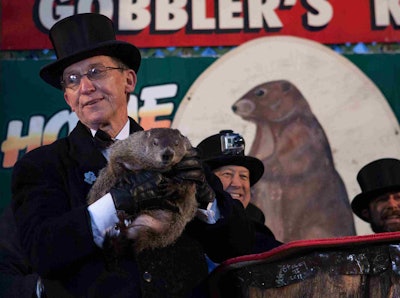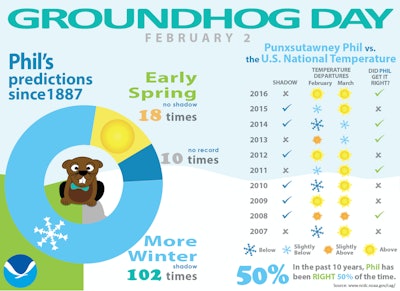 It is uncertain how many groundhogs have played Punxsutawney Phil, as the Groundhog Club insists there is only one Phil who receives his longevity from drinking “groundhog punch.”
It is uncertain how many groundhogs have played Punxsutawney Phil, as the Groundhog Club insists there is only one Phil who receives his longevity from drinking “groundhog punch.”Photo: Anthony Quintano/Flickr
It’s Groundhog Day and Punxsutawney Phil has NOT seen his shadow. Everyone knows that is supposed to mean an early spring. But how did we get to this bizarre ritual?
Like most holidays, Groundhog Day’s earliest roots come from a pagan festival, known as Imbolc. Many ancient cultures marked the calendar by equinoxes and solstices, but the Celts also celebrated the “cross quarters,” which marked midpoints between the solstices and equinoxes.
Because Imbolc fell between the winter solstice and spring equinox, it was viewed as a turning point in the season and people began to search for omens that an early spring was on its way. It soon became a tradition to watch for the emergence of hibernating animals, from serpents to badgers.
As Christianity became the dominant religion in Europe, Candlemas was celebrated instead, commemorating the presentation of Jesus at the Temple. Candles were blessed and distributed, although that observance came to be associated with weather forecasting as well.
Fast forward to the 1700s: German settlers arrived in America and continued to carry on their tradition in Pennsylvania, replacing their hedgehogs and badgers with the native groundhog.
The first recorded reference to Groundhog Day was in 1841, when James Morris of Morgantown, Pennsylvania, wrote: “Last Tuesday, the 2nd, was Candlemas day, the day on which according to the Germans, the Groundhog peeps out of his winter quarters and if he sees his shadow he pops back for another six weeks nap, but if the day be cloudy he remains out, as the weather is to be moderate.”
In 1887, a newspaper editor declared that Phil, the Punxsutawney groundhog, was America’s only true weather-forecasting groundhog.
Although Phil is definitely the most famous groundhog, many other towns have their own prophesying rodents. Overall, Phil’s predictions since 1887 have only been correct 39 percent of the time. In the past 10 years, however, he’s gotten it right 50 percent of the time, according to the National Centers for Environmental Information.
Here’s an infographic of the furry forecaster’s recent prognostications compared with the national temperatures of February and March:










